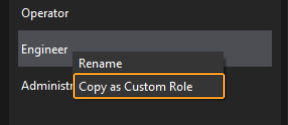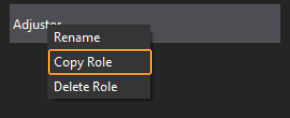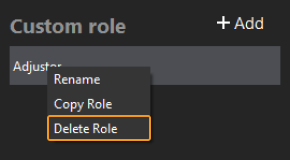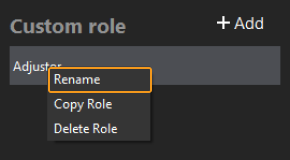Manage Solution Access Control
This section introduces how administrators can manage solution permissions. The main process is illustrated in the following figure.

-
Enable solution access control: Add an administrator, enable the solution access control feature for the solution, and then the administrator can manage solution permissions.
-
Configure the required roles: Configure the necessary roles for the solution, including configuring default roles and adding custom roles (optional).
-
Configure permissions for roles: Configure the required permissions for custom roles.
-
Add accounts to roles: Add accounts to each role.
Enable Solution Access Control
The software defaults to disabling access control for solutions, allowing any user to open and perform any operations on the solution. Please follow the steps below to enable the solution access control:
-
Right-click the solution name in the project list, and then click Solution Access Control in the shortcut menu to use this feature.
-
Enter a username and password in the pop-up window to add an administrator, and then click OK to enter the “Solution Access Control” interface.
Once the administrator is added to the solution, the solution access control will take effect. Afterward, when users open the solution, they need to enter the username and password (the default login method) on the login interface to obtain the corresponding roles and permissions.
|
If a solution and unassigned project are opened at the same time, the access control for the unassigned project will be the same as the solution once the solution access control is enabled. |
Configure the Required Roles
The feature provides four default roles, including Administrator, Engineer, Operator, and Observer. As different roles are equipped with different operation permissions, a brief introduction is shown below. To learn about the detailed introduction, please refer to Appendix.
-
Administrator: All permissions relevant to the solution, including view permissions, operation permissions, production task permissions, role management, account management, and advanced settings.
-
Engineer: View permissions, operation permissions, and production task permissions.
-
Operator: View permissions, production task permissions, and operation permissions excluding "Debugging tools" and "Modify project and parameters".
-
Observer: Only view permissions.
If the four default roles cannot meet on-site requirements, the solution access control feature allows the configuration of custom roles, enabling customized permission control.
Use the Default Roles
The solution access control feature provides four built-in default roles, which can only be renamed, and cannot be added or deleted.
If you want to rename the default role, right-click the role, select Rename, and then enter the new name in the pop-up window.
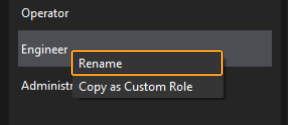
Use Custom Roles
To add a custom role, click on Add in the custom role list, then enter the new role name in the pop-up window to add a custom role.
For additional configuration operations related to custom roles, please refer to the Role Management.
Configure Permissions for Roles (Custom Roles)
The permissions of the default roles are fixed and cannot be modified. The system can only support configuring permissions for custom roles.
To configure permissions for a custom role, you can select this role, and then configure permissions in the Permission Management interface. When the permission management is completed, click Save.
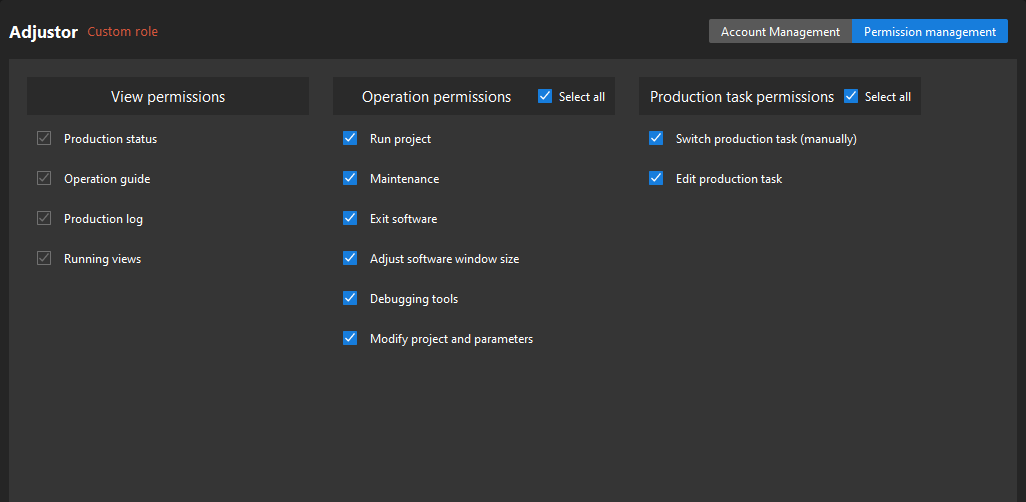
Adding Accounts to Roles
After configuring roles, it is necessary to add accounts to the roles. Once the role is selected, you can add accounts in the account management interface. There are two kinds to add accounts. The detailed description is shown below.
Add one account
Click the Add account button on the top of the account list, and then enter the username and password in the pop-up window to add an account under the role.
|
When adding the account, both the usernames and their passwords should be unique. |

Batch import
Click the ![]() button on the right side of the Add account button, and then select Batch import. Follow the tips in the new window to perform operations.
button on the right side of the Add account button, and then select Batch import. Follow the tips in the new window to perform operations.
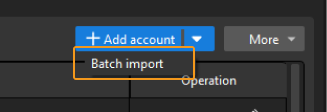
|
When importing accounts in batches, please pay attention to:
|
Now you have completed operations related to managing solution permissions. For further information on other operations, please refer to the following sections.
Other Operations
Role Management
You can add, delete, and rename the custom roles. The detailed description is as follows.
| Operation | Description | Illustration |
|---|---|---|
Copy the default role as a custom role |
Right-click the default role, select Copy as Custom Role, and then enter the new name in the pop-up window. |
|
Right-click the added custom role, select Copy Role, and then enter the new name in the pop-up window. |
|
|
Delete custom role |
Right-click this role, and select Delete Role. |
|
Rename custom role |
Right-click the role, select Rename, and then enter the new name in the pop-up window. |
|
Account Management
Edit Headings of Account List
When the default headings of the account list cannot meet the requirements, you can customize the headings.
Click the More button at the top right of the account list and select Set heading. Then you can add new headings in the Set Heading window.

The figure below shows the account information after adding a “Name” column. Then click the ![]() icon in the Operation column to customize the name.
icon in the Operation column to customize the name.

Reset Account Password
When users forget the account password, the administrator can reset the password. As an administrator, follow the steps below to reset the password.
Click ![]() in the Operation column, enter a new password in the pop-up window, and click OK.
in the Operation column, enter a new password in the pop-up window, and click OK.
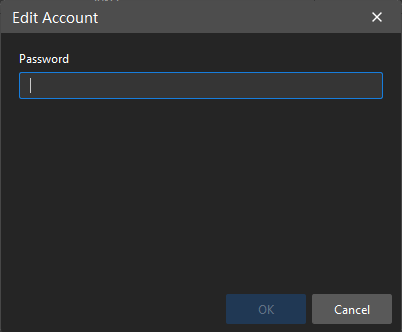
Permission Management (Custom Roles)
The permissions of the default roles are fixed and cannot be modified. Only the permissions for custom roles can be modified.
Modify Permissions
After completing the permission configuration, if you need to modify permissions, click Permission management in the upper right corner to enter the permission management interface. Then, select or unselect the permission checkboxes, and then click Save.
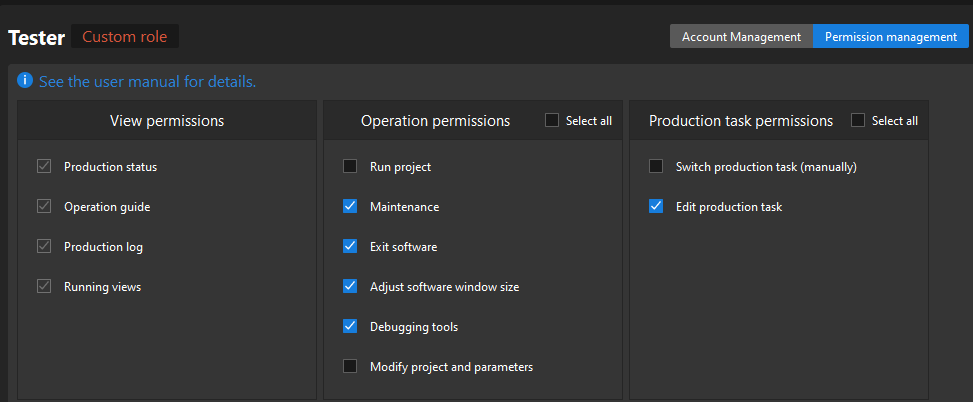
Reset Permissions
If you need to reset permissions after completing the permission configuration, click Permission management in the upper right corner to enter the permission management interface. Then, click Reset in the lower right corner, and then click Save to reset the permissions.
After resetting, the role will only have default permissions.
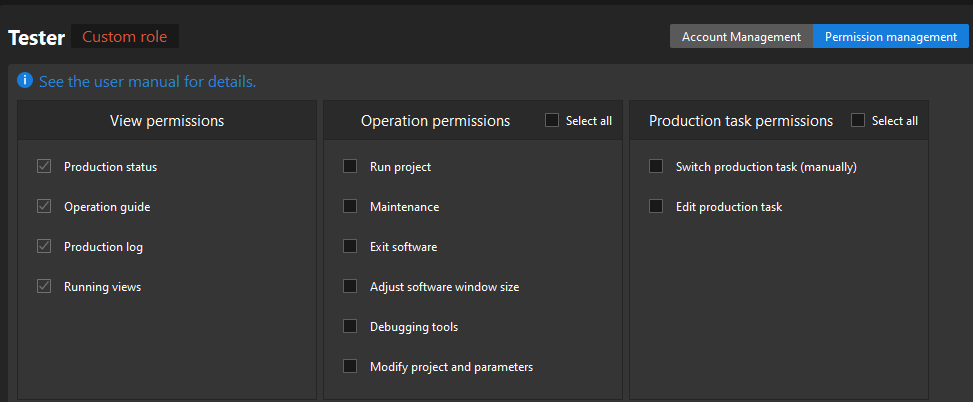
Advanced Settings
In the advanced settings, the functions including “Delete all account,” “Auto logout after inactivity,” and “Login settings” are provided. Please use these functions according to actual requirements.
| No. | Function | Operating Instruction |
|---|---|---|
1 |
Delete all account |
This operation will clear the accounts of all default and custom roles, delete all custom roles, and disable the access control for this solution. |
2 |
Auto logout after inactivity |
Enable auto logout after inactivity for roles. After the set period of inactivity, the role will be automatically logged out. The period can range from 1 to 120 min. |
3 |
Login settings |
Set login method and background. |
